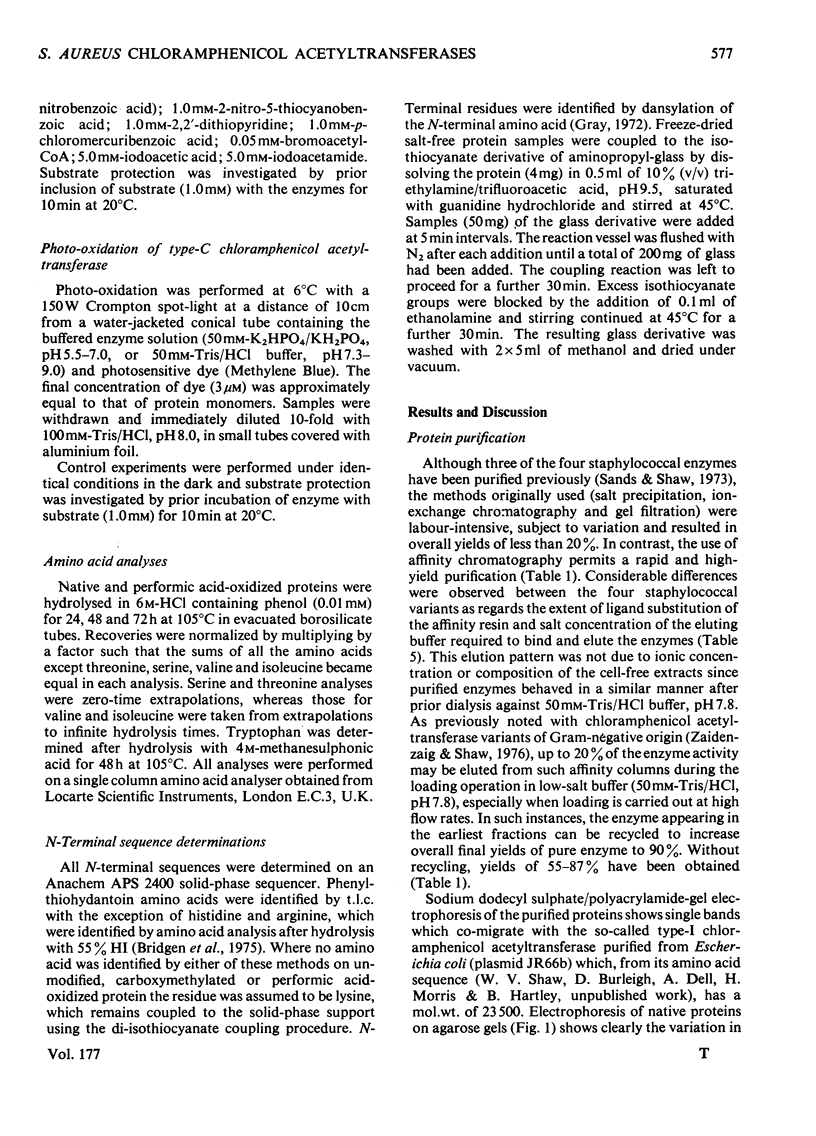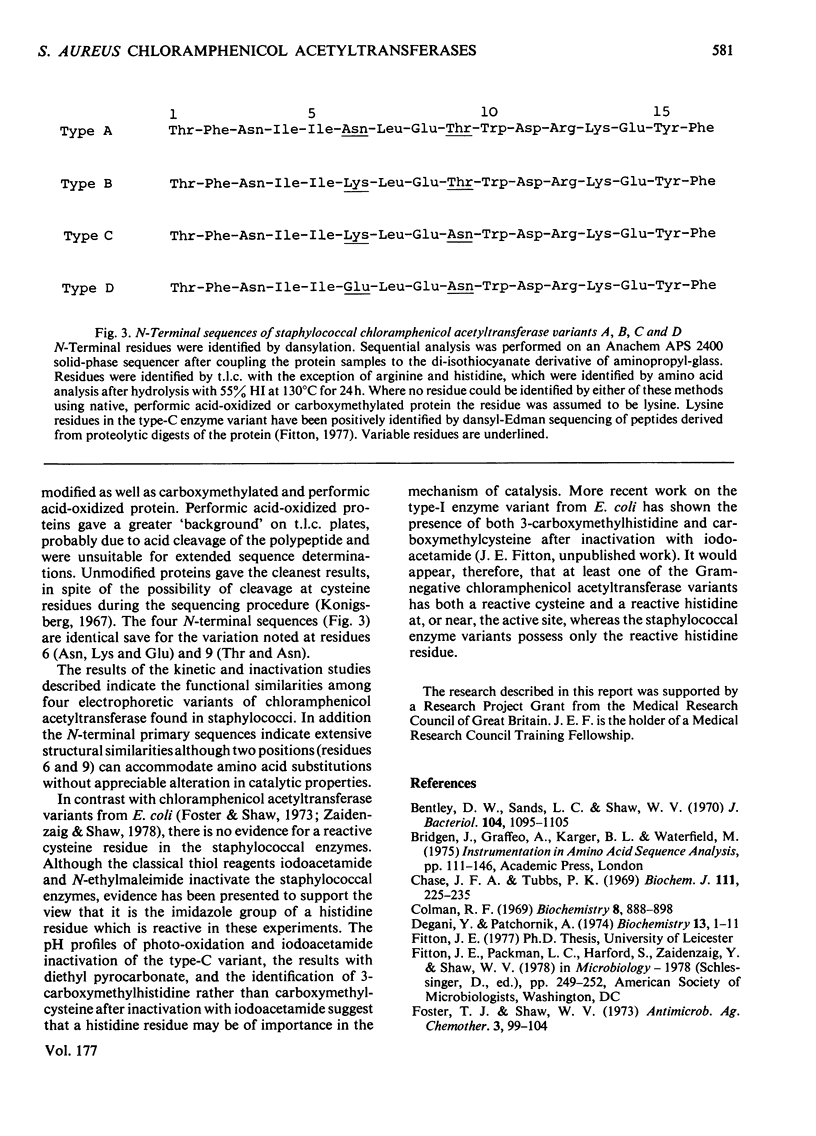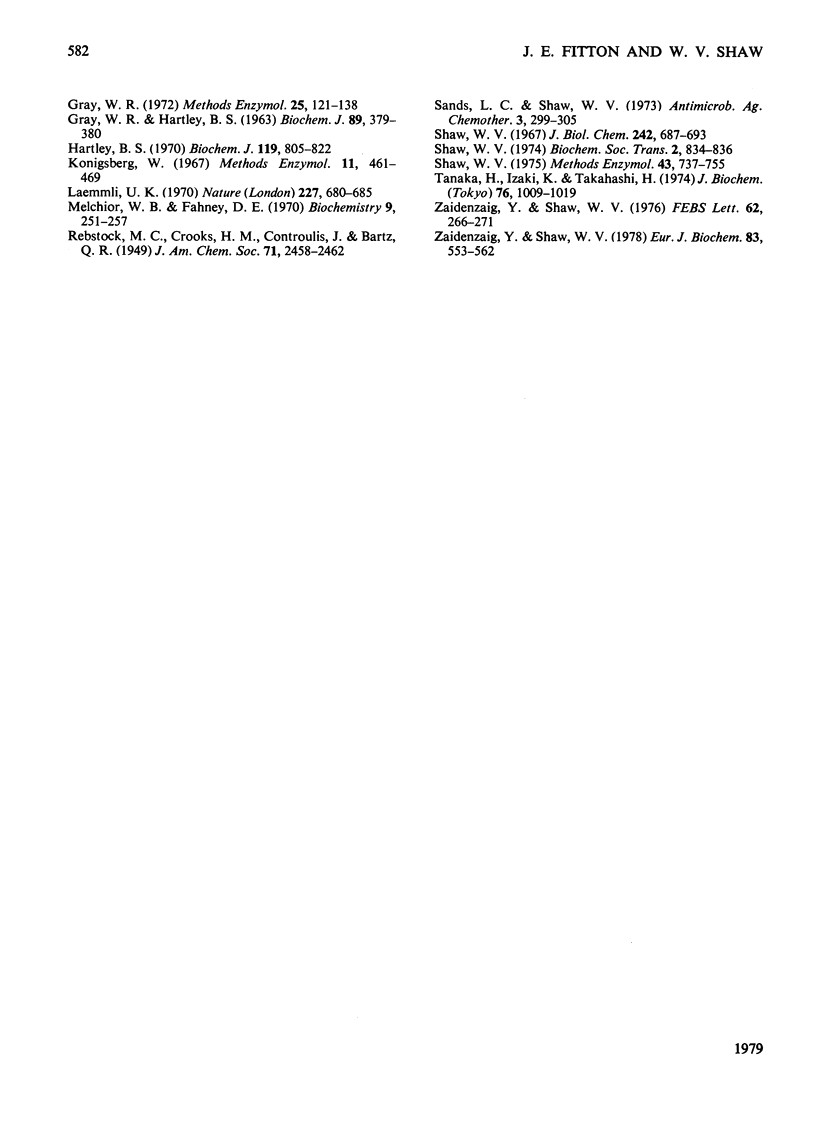Abstract
Four electrophoretic variants of chloramphenicol acetyltransferase (types A, B, C and D) found in chloramphenicol-resistant staphylococci were purified by affinity chromatography. Michaelis constants and the kinetics of inactivation with a variety of reagents for the four variants are virtually identical. Their similar amino acid compositions and near identical N-terminal sequences suggest a high degree of overall sequence homology. The thiol-specific reagents 5,5'-dithiobis-(2-nitrobenzoic acid), 2-nitro-5-thiocyanobenzoic acid and 2,2'-dithiopyridine are without significant effect on enzyme activity, whereas 1-fluoro-2,4-dinitrobenzene, N-ethylmaleimide, p-chloromercuribenzoic acid, iodoacetamide, and, particularly, bromoacetyl-CoA and diethyl pyrocarbonate are potent inhibitors. Iodoacetate is not an inhibitor. The results of chemical modification studies on the four enzyme variants and the identification of 3-carboxymethylhistidine in acid hydrolysates of one variant (type C) after inactivation with iodoacetamide suggest that a unique histidine residue may be involved in the mechanism of catalysis.
Full text
PDF







Images in this article
Selected References
These references are in PubMed. This may not be the complete list of references from this article.
- Chase J. F., Tubbs P. K. Conditions for the self-catalysed inactivation of carnitine acetyltransferase. A novel form of enzyme inhibition. Biochem J. 1969 Jan;111(2):225–235. doi: 10.1042/bj1110225. [DOI] [PMC free article] [PubMed] [Google Scholar]
- Colman R. F. The role of sulfhydryl groups in the catalytic function of isocitrate dehydrogenase. I. Reaction with 5,5'-dithiobis(2-nitrobenzoic acid). Biochemistry. 1969 Mar;8(3):888–898. doi: 10.1021/bi00831a019. [DOI] [PubMed] [Google Scholar]
- Degani Y., Patchornik A. Cyanylation of sulfhydryl groups by 2-nitro-5-thiocyanobenzoic acid. High-yield modification and cleavage of peptides at cysteine residues. Biochemistry. 1974 Jan 1;13(1):1–11. doi: 10.1021/bi00698a001. [DOI] [PubMed] [Google Scholar]
- Foster T. J., Shaw W. V. Chloramphenicol acetyltransferases specified by fi minus R factors. Antimicrob Agents Chemother. 1973 Jan;3(1):99–104. doi: 10.1128/aac.3.1.99. [DOI] [PMC free article] [PubMed] [Google Scholar]
- GRAY W. R., HARTLEY B. S. THE STRUCTURE OF A CHYMOTRYPTIC PEPTIDE FROM PSEUDOMONAS CYTOCHROME C-551. Biochem J. 1963 Nov;89:379–380. doi: 10.1042/bj0890379. [DOI] [PubMed] [Google Scholar]
- Hartley B. S. Strategy and tactics in protein chemistry. Biochem J. 1970 Oct;119(5):805–822. doi: 10.1042/bj1190805f. [DOI] [PMC free article] [PubMed] [Google Scholar]
- Laemmli U. K. Cleavage of structural proteins during the assembly of the head of bacteriophage T4. Nature. 1970 Aug 15;227(5259):680–685. doi: 10.1038/227680a0. [DOI] [PubMed] [Google Scholar]
- Melchior W. B., Jr, Fahrney D. Ethoxyformylation of proteins. Reaction of ethoxyformic anhydride with alpha-chymotrypsin, pepsin, and pancreatic ribonuclease at pH 4. Biochemistry. 1970 Jan 20;9(2):251–258. doi: 10.1021/bi00804a010. [DOI] [PubMed] [Google Scholar]
- Sands L. C., Shaw W. V. Mechanism of chloramphenicol resistance in staphylococci: characterization and hybridization of variants of chloramphenicol acetyltransferase. Antimicrob Agents Chemother. 1973 Feb;3(2):299–305. doi: 10.1128/aac.3.2.299. [DOI] [PMC free article] [PubMed] [Google Scholar]
- Shaw W. V., Bentley D. W., Sands L. Mechanism of Chloramphenicol Resistance in Staphylococcus epidermidis. J Bacteriol. 1970 Dec;104(3):1095–1105. doi: 10.1128/jb.104.3.1095-1105.1970. [DOI] [PMC free article] [PubMed] [Google Scholar]
- Shaw W. V. Chloramphenicol acetyltransferase from chloramphenicol-resistant bacteria. Methods Enzymol. 1975;43:737–755. doi: 10.1016/0076-6879(75)43141-x. [DOI] [PubMed] [Google Scholar]
- Shaw W. V. The enzymatic acetylation of chloramphenicol by extracts of R factor-resistant Escherichia coli. J Biol Chem. 1967 Feb 25;242(4):687–693. [PubMed] [Google Scholar]
- Tanaka H., Izaki K., Takahashi H. Some properties of chloramphenicol acetyltransferase, with particular reference to the mechanism of inhibition by basic triphenylmethane dyes. J Biochem. 1974 Nov;76(5):1009–1019. [PubMed] [Google Scholar]
- Zaidenzaig Y., Shaw W. V. Affinity and hydrophobic chromatography of three variants of chloramphenicol acetyltransferases specified by R factors in Escherichia coli. FEBS Lett. 1976 Mar 1;62(3):266–271. doi: 10.1016/0014-5793(76)80072-5. [DOI] [PubMed] [Google Scholar]
- Zaidenzaig Y., Shaw W. V. The reactivity of sulfhydryl groups at the active site of an F-factor--specified variant of chloramphenicol acetyltransferase. Eur J Biochem. 1978 Feb;83(2):553–562. doi: 10.1111/j.1432-1033.1978.tb12123.x. [DOI] [PubMed] [Google Scholar]



